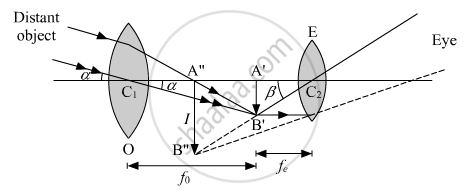Advertisements
Advertisements
प्रश्न
Draw a ray diagram showing the image formation of a distant object by a refracting telescope ?
उत्तर

APPEARS IN
संबंधित प्रश्न
- A giant refracting telescope at an observatory has an objective lens of focal length 15 m. If an eyepiece of focal length 1.0 cm is used, what is the angular magnification of the telescope?
- If this telescope is used to view the moon, what is the diameter of the image of the moon formed by the objective lens? The diameter of the moon is 3.48 × 106 m, and the radius of lunar orbit is 3.8 × 108 m.
- For the telescope is in normal adjustment (i.e., when the final image is at infinity)? what is the separation between the objective lens and the eyepiece?
- If this telescope is used to view a 100 m tall tower 3 km away, what is the height of the image of the tower formed by the objective lens?
- What is the height of the final image of the tower if it is formed at 25 cm?
A small telescope has an objective lens of focal length 150 cm and an eye piece of focal length 5 cm. If this telescope is used to view a 100 m high tower 3 km away, find the height of the final image when it is formed 25 cm away from the eye piece.
A giant refracting telescope at an observatory has an objective lens of focal length 15 m. If an eyepiece lens of focal length 1.0 cm is used, find the angular magnification of the telescope. If this telescope is used to view the moon, what is the diameter of the image of the moon formed by the objective lens? The diameter of the moon is 3.42 × 106 m and the radius of the lunar orbit is 3.8 × 108 m.
A lady cannot see objects closer than 40 cm from the left eye and closer than 100 cm from the right eye. While on a mountaineering trip, she is lost from her team. She tries to make an astronomical telescope from her reading glasses to look for her teammates. (a) Which glass should she use as the eyepiece? (b) What magnification can she get with relaxed eye?
Read the following paragraph and answer the questions.
| A number of optical devices and instruments have been designed and developed such as periscope, binoculars, microscopes and telescopes utilising the reflecting and refracting properties of mirrors, lenses and prisms. Most of them are in common use. Our knowledge about the formation of images by the mirrors and lenses is the basic requirement for understanding the working of these devices. |
- Why the image formed at infinity is often considered most suitable for viewing. Explain
- In modern microscopes, multicomponent lenses are used for both the objective and the eyepiece. Why?
- Write two points of difference between a compound microscope and an astronomical telescope
OR
Write two distinct advantages of a reflecting type telescope over a refracting type telescope.
With the help of a ray diagram explain the working of a reflecting telescope.
The magnifying power of an astronomical telescope in normal adjustment is 2.9 and the objective and the eyepiece are separated by a distance of 150 cm. Find the focal lengths of the two lenses.
In an astronomical telescope in normal adjustment, a straight black line of length L is drawn on the objective lens. The eyepiece forms a real image of this line whose length is 𝑙. What is the angular magnification of the telescope?
Assertion: An astronomical telescope has an objective lens having large focal length.
Reason: Magnifying power of an astronomical telescope varies directly with focal length of the objective lens.
